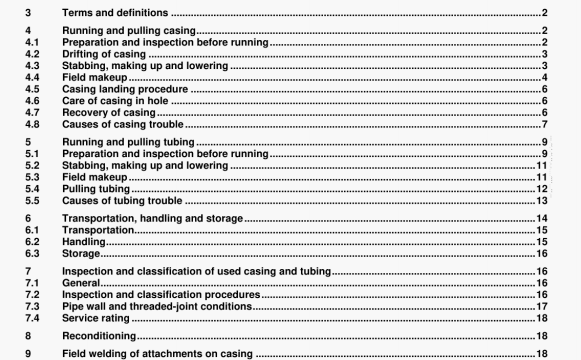ISO 10405 pdf download – Petroleum and natural gas industries一 Care and use of casing and tubing.
5.3.2 When making up round-thread connections with PTFE (potytetratluoroethylene) rings, 70 % of the listed values are recommended. As with standard couplings, makeup positions shall govern. Buttress connections with PTFE seal nngs may make up at torque values different from those normally observed on standard buttress threads
NOTE Thread galling of gall-prone matei (m erwlt* chromium steels. 9Cr and 19Cr, cijples stainless stoIs and lI base albys) occurs dunng movement — stabbing or pung and makeup or breakout. Galing resistance of ttweads Is prInrlly controlled m two areas — surface preparation and finishing during manufacture and carehi handhng practices during running and pub’ig. Threads and lubncant shall be dean, Assembly in the horizontal position should be avoided Connections should be turned by hand to the hand-tight position before slowly power-tightening. The procedure shoutd be reversed Icr disassembly.
5.3.3 Spider slips and elevalors should be cleaned frequently, and slips should be kept sharp.
5.3.4 Fwiding bottom should be accomplished with extreme caution. Do not set tubing down heavly.
5.4 Pulling tubing
5.4.1 A caliper survey prior to pulling a worn string of tubing will provide a quick means of segregating badly worn lengths for removal
5.4.2 Breakout tongs should be positioned close to the coupling. l’lanirnering the coupling to break the joint is an injurious practice. When tapping is required, use the flat face, never the peen face, of the hammer, and lap lightly at the middle and completely around the coupling, never near the end or on opposite sides only.
5.4.3 Great care should be exercised to disengage all of the thread before lifting the tubing out of the coupling. Do not jump tubing out of the coupling.
54.4 Tubing stacked in the derrick should be set on a firm wooden platform and without the bottom thread protector since the design of most protectors is not such as to support the point or stand without damage to the field thread.
5.4.5 Protect threads from dirt or injury when the tubing is out of the hole.
5.4.6 Tubing set back in the derrick should be property supported to prevent undue bending. Tubing 60,3 mm (2318-in) OD and larger preferably should be pulled in stands approximately 18,3 m (60 ft) long or in doubles of range 2. Stands of tubing 48.3mm (1 9-in) 00 or smaller and stands longer than 18,3 m (GO It) should have intermediate support.
5.4.7 Before leaving a location, always firmly tie a setback of tubing in place.
5.4.8 Make sure threads are undamaged. clean arid weU coated with compound before rerunning.
5.4.9 Distribute joint and tubing wear by moving a length from the top of the string to the bottom each time the tubing is pulled.
5.4.10 In order to avoid leaks, all joints should be ref ightened occasionally.
5.4.11 When tubing is stuck, the best practice is to use a calibrated weight indicator. Do not be misled, by stretching of the tubing string, into the assumption that the tubing is free,
5.4.12 After a hard pull to loosen a string of tubing, all joints pulled on should be retightened
5.4.13 All threads should be cleaned and lubricated or should be coated with a material that will mirmize corrosion. Clean protectors should be placed on the tubing before it is laid down.
5.4.14 Before tubing is stored or reused, pipe and threads should be inspected and detective points marked for shopping and regauging.
5.5 Causes of tubing trouble
5.5.1 The most common causes of tubing trouble are listed in 5.5.2105.5.16.
5.52 Improper selection for the strength and life required, especially of nonupset tubEig where upset tiAing should be ised.
5.5.3 Insufficient inspection of finished product at the mill or in the yard.
5.5.4 Careless loading, unloading or cartage.
5.5.5 Damaged threads resulting from protectors loosening and falling off.
5.5.6 Lack of care in storage to give proper protection
5,5.7 Excessive hamnierng on couplings.
5.5.8 Use of worn-out or wrong types of handling equipment. spiders. tongs, dies or pipe wrenches.
5.5.9 Nonobservance of proper rules in running or pulling ting.
5.5.10 Coupling wear or rod cutting.
5.5.11 Excessive sucker rod breakage.
5.5.12 Fahgue. wtiidl often causes failure at the last engaged thread. There is no positive remedy, but using external.upset tubing In place of nonupset tubing greatly delays the stan of this trouble.
5.5.13 Replacement of worn couplings with out-o$-specihcation couplings
5.5.14 Dropprng a string, even a short distance. This may loosen the couplings at the bottom of the string, The string should be pulled arid rerun, examining all joints very carefully.
5.5.15 Leaking joints, under external or internal pressure, are a common cause of trouble, and may be due to the following:
a) improper thread compound andor improper application:
b) dirty threads, or threads contaminated with coating material used as protection from corrosion;
C) undenlonging or overtonging:
41) galled threads due to dirt, careless stabbing, damaged threads or poor or diluted thread compound;
e) improperly cut field threads:
f) couplings that have been dented by hammering:
g) pulling too hard on the string;
h) excessive rerunning.
ISO 10405 pdf download – Petroleum and natural gas industries一 Care and use of casing and tubing
